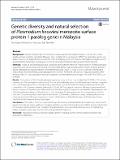Files in this item
Genetic diversity and natural selection of Plasmodium knowlesi merozoite surface protein 1 paralog gene in Malaysia
Item metadata
| dc.contributor.author | Ahmed, Md Atique | |
| dc.contributor.author | Fauzi, Muh | |
| dc.contributor.author | Han, Eun-Taek | |
| dc.date.accessioned | 2019-07-18T12:30:02Z | |
| dc.date.available | 2019-07-18T12:30:02Z | |
| dc.date.issued | 2018-03-14 | |
| dc.identifier | 259673481 | |
| dc.identifier | e04385ef-1ed6-49c5-9bdb-0e37dcbf73a0 | |
| dc.identifier | 000427683300003 | |
| dc.identifier | 85043769007 | |
| dc.identifier.citation | Ahmed , M A , Fauzi , M & Han , E-T 2018 , ' Genetic diversity and natural selection of Plasmodium knowlesi merozoite surface protein 1 paralog gene in Malaysia ' , Malaria Journal , vol. 17 , 115 . https://doi.org/10.1186/s12936-018-2256-y | en |
| dc.identifier.issn | 1475-2875 | |
| dc.identifier.other | ORCID: /0000-0002-3966-9110/work/59698778 | |
| dc.identifier.uri | https://hdl.handle.net/10023/18125 | |
| dc.description.abstract | Background: Human infections due to the monkey malaria parasite Plasmodium knowlesi is on the rise in most Southeast Asian countries specifically Malaysia. The C-terminal 19 kDa domain of PvMSP1P is a potential vaccine candidate, however, no study has been conducted in the orthologous gene of P. knowlesi. This study investigates level of polymorphisms, haplotypes and natural selection of full-length pkmsp1p in clinical samples from Malaysia. Methods: A total of 36 full-length pkmsp1p sequences along with the reference H-strain and 40 C-terminal pkmsp1p sequences from clinical isolates of Malaysia were downloaded from published genomes. Genetic diversity, polymorphism, haplotype and natural selection were determined using DnaSP 5.10 and MEGA 5.0 software. Genealogical relationships were determined using haplotype network tree in NETWORK software v5.0. Population genetic differentiation index (FST) and population structure of parasite was determined using Arlequin v3.5 and STRU CTU RE v2.3.4 software. Results: Comparison of 36 full-length pkmsp1p sequences along with the H-strain identified 339 SNPs (175 non-synonymous and 164 synonymous substitutions). The nucleotide diversity across the full-length gene was low compared to its ortholog pvmsp1p. The nucleotide diversity was higher toward the N-terminal domains (pkmsp1p-83 and 30) compared to the C-terminal domains (pkmsp1p-38, 33 and 19). Phylogenetic analysis of full-length genes identified 2 distinct clusters of P. knowlesi from Malaysian Borneo. The 40 pkmsp1p-19 sequences showed low polymorphisms with 16 polymorphisms leading to 18 haplotypes. In total there were 10 synonymous and 6 non-synonymous substitutions and 12 cysteine residues were intact within the two EGF domains. Evidence of strong purifying selection was observed within the full-length sequences as well in all the domains. Shared haplotypes of 40 pkmsp1p-19 were identified within Malaysian Borneo haplotypes. Conclusions: This study is the first to report on the genetic diversity and natural selection of pkmsp1p. A low level of genetic diversity and strong evidence of negative selection was detected and observed in all the domains of pkmsp1p of P. knowlesi indicating functional constrains. Shared haplotypes were identified within pkmsp1p-19 highlighting further evaluation using larger number of clinical samples from Malaysia. | |
| dc.format.extent | 11 | |
| dc.format.extent | 1409908 | |
| dc.language.iso | eng | |
| dc.relation.ispartof | Malaria Journal | en |
| dc.subject | Plasmodium knowlesi | en |
| dc.subject | Merozoite surface protein 1 paralog | en |
| dc.subject | Genetic diversity | en |
| dc.subject | Natural selection | en |
| dc.subject | Subpopulations | en |
| dc.subject | Haplotypes | en |
| dc.subject | QH426 Genetics | en |
| dc.subject | RM Therapeutics. Pharmacology | en |
| dc.subject | 3rd-DAS | en |
| dc.subject | SDG 3 - Good Health and Well-being | en |
| dc.subject.lcc | QH426 | en |
| dc.subject.lcc | RM | en |
| dc.title | Genetic diversity and natural selection of Plasmodium knowlesi merozoite surface protein 1 paralog gene in Malaysia | en |
| dc.type | Journal article | en |
| dc.contributor.institution | University of St Andrews. School of Medicine | en |
| dc.identifier.doi | 10.1186/s12936-018-2256-y | |
| dc.description.status | Peer reviewed | en |
This item appears in the following Collection(s)
Items in the St Andrews Research Repository are protected by copyright, with all rights reserved, unless otherwise indicated.

